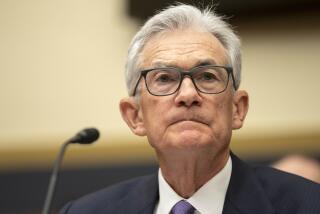Recession Has Bottomed Out, Greenspan Says : Economy: The Fed chairman’s testimony is more pessimistic than earlier remarks. He is cautious on whether a recovery is under way.
- Share via
WASHINGTON — Federal Reserve Board Chairman Alan Greenspan said Tuesday that the nation’s recession has bottomed out, but he cautioned that it is still too early to tell whether the recovery has actually begun.
Greenspan’s remarks sounded a somewhat more pessimistic tone than those he made earlier this month while visiting Japan, when he said the American economy might be poised for a stronger recovery than many economists anticipate.
His comments Tuesday before the House Ways and Means Committee may have been designed to deflect a growing belief on Wall Street that Greenspan and other senior Fed officials have become unrealistically optimistic on the economic outlook.
Still, Tuesday’s statements marked only a subtle change from his earlier observations, and Greenspan apparently continues to believe that further interest rate cuts are not needed to help end the recession. During the past few months, in fact, Greenspan has warned that one of the worst mistakes the Fed can make is to cut rates too much just before the economy turns, leading to higher inflation down the road.
“It’s possible that we are at the bottom right in here,” Greenspan said Tuesday, when asked when he expected the recession to end. “It’s very difficult to get around the data of the last several weeks, which are strongly suggestive that the bottom is somewhere in the second quarter.”
Greenspan also believes that inflation will not be a serious problem for the remainder of the year--another indication that he is satisfied with the Fed’s current policies.
“I’m confident that we can come out of this with a recovery without concurrently reigniting inflationary forces, which inevitably, within a reasonably short period, create the next recession,” he said.
But Greenspan quickly qualified his forecast. “We don’t yet see any measurable upward thrust” to the economy, the Fed chairman said. “We are still too close to it to know for sure.”
Other Fed officials also fell in line Tuesday with Greenspan’s effort to downplay the magnitude of the coming recovery.
“The recovery is not likely to be quite as robust as an average recovery,” David Mullins, a member of the Federal Reserve’s board of governors, told the Senate Banking Committee.
Mullins, a former Bush Administration official who has been nominated to be the Fed’s vice chairman, also said he agreed with the Fed’s decision not to cut rates further. Any effort by the central bank to follow a more aggressive course would cause jitters over rising inflation in the financial markets, prompting long-term interest rates to rise, he warned.
Greenspan also said that with real estate markets across the nation still weak, the economic picture is still quite mixed. And he cautioned that the unemployment rate, which traditionally lags behind a recovery, probably will stay high for several more months. He noted that as consumer demand rises, corporations probably will try to increase factory production without adding new workers; that should delay employment gains until the recovery gathers more steam.
“I would expect the recovery as it emerges will be more evident on the goods and services side than on the employment side,” Greenspan said.
Greenspan’s forecast came as the government reported that housing starts inched up again in May for the second straight month, suggesting that the housing market is finally beginning to stabilize.
The Commerce Department said Tuesday that the pace of construction of new homes and apartments nationwide rose by 0.1% during May. The government said new starts of homes and apartments rose to a seasonally adjusted annual rate of 982,000 units. In April, housing starts rose 8.2%. It represents the first time that housing starts have risen for two straight months since June and July, 1989.
But although housing market seems to be stabilizing, the construction industry is still coming off one of the worst downturns in recent memory. Housing starts in May were still 18.7% lower than a year ago, the Commerce Department said.
The Economy: Housing Starts Gain Indicator: Construction of new homes and apartments in May.
What it did: Rose 0.1%. Housing starts totaled a seasonally adjusted annual rate of 982,000, up from a revised 981,000 in April and 907,000 in March. The increase was the first back-to-back advance since June and July, 1989.
What it means: The figures support analysts’ forecasts of a slower-than-normal housing recovery.. “We’re not expecting an increase in housing starts at the torrid pace of past recoveries,” said economist Richard Peach of the Mortgage Bankers Assn. David F. Seiders, chief economist with the National Assn. of Home Builders, concurred: “We’re moving along at a sub-par recovery pace.”
Highlights: New construction of single-family homes rose 3.1% to an 832,000 rate, after an 8.8% jump a month earlier. Multifamily starts, on the other hand, fell 13.8%. Starts of buildings with five units or more plunged 16.3%, the lowest since the department began keeping records in 1963.
Housing Starts Seasonally adjusted annual rate, millions of units May, ‘91: 0.98 April, ‘91: 0.98 May, ‘90: 1.21 Source: Commerce Department
More to Read
Get the L.A. Times Politics newsletter
Deeply reported insights into legislation, politics and policy from Sacramento, Washington and beyond. In your inbox twice per week.
You may occasionally receive promotional content from the Los Angeles Times.










